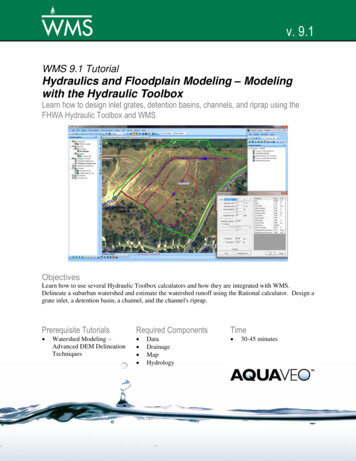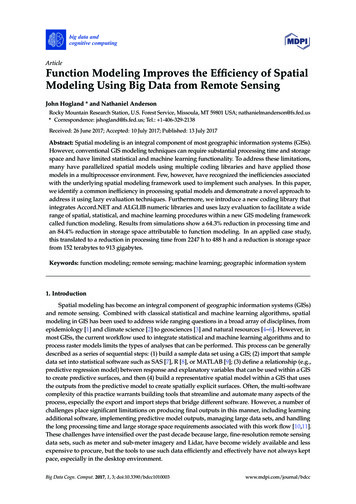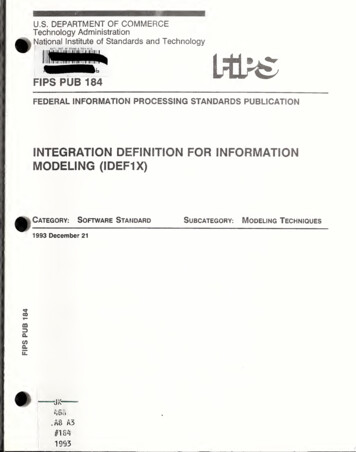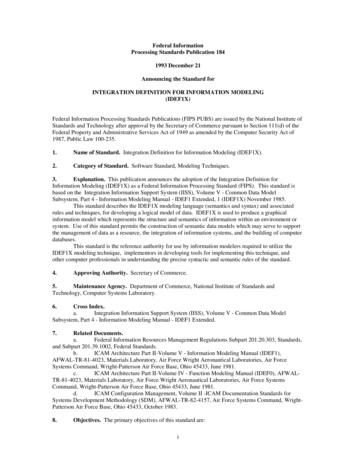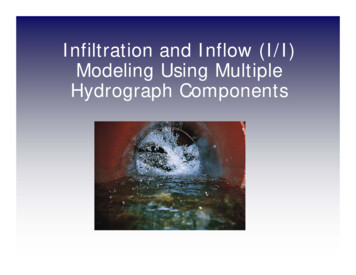
Transcription
Infiltration and Inflow (I/I)Modeling Using MultipleHydrograph Components
I/I ProjectArea 34 Local ComponentAgencies Most of Seattle isCombined System 75% of Peak Flows inKing County System isI/I 95% of I/I is fromLocal Agencies 50% From PrivateProperty
I/I Program Objectives I/I program is part of The Regional WastewaterServices Plan (RWSP) Determine the Amount of I/I Received by KingCounty from Each Local Agency Identify Major I/I Areas Within Local CollectionSystems Identify Specific Types of I/I Occurring WithinThese Areas Forecast the Amount of I/I that can be RemovedCost-Effectively Develop a Proactive Regional Strategy for I/IRemoval and Control
Why Use Computer Modeling? Estimate Peak I/I Using Limited MeasuredData (amplifying the data) Distinguish Inflow from Infiltration Consider Design Flow Conditions Evaluate Multiple Scenarios and SystemOptions
Technical Process OverviewRWSP SavingsEstimatesBased on OriginalStudy AssumptionsFlow & RainfallMonitoringI/IModelingIsolates Inflowvs. InfiltrationDeterminesSeverity of I/IAssessmentProtocolsRanked BasinsTargets forRehabilitationRevised Findingsper Pilot ProjectResultsI/I ReductionCostBased onExperienceIndustry StandardsPilot Projects
Overview of Supporting Data
Measured Data for ModelDevelopment Rainfall Evapotranspiration Measured Flow Data Basin Information– Sewered Area– Dry Weather Flow Pattern
Rain Data andCALAMAR Service area 25 x 45 miles Rainfall Measurement withGauge-adjusted NEXRADData 5 Minute Data in 1 Km2Pixels for specific storms 8 Calibration Zones Gauge Data insertedbetween storms
Flow Monitoring Effort 804 Meters in Simultaneous Operation 2 Wet Seasons of Flow Data 150 for Initial Model Calibration 75 Long Term Meters for Trends Analysis 95% of Agency Sewers in a Mini Basin
Model and Mini-Basins Model Basins"8 Calibrated to flowsmeasured during 2wet seasons 1,000 acres 100,000 linear feet"8#S"8"8"8 Mini-Basins 10 weeks of measuredflow 150 acres 22,000 linear feet#"8"8"8"8
Model BasinDefinition 150 Model Basins Isolate FlowContributions Evaluate SystemPerformance
MOUSE RDII ModelDevelopment and Calibration
Components of FlowRainfallEventFlowResponseTotal FlowInflowRainfallDependentInfiltration Dry WeatherFlowGround WaterInfiltration
RDII ComponentsRAINFALLPOTENTIAL EVAPORATIONMODELPARAMETERSRDII COMPONENTSEVAPORATIONRECHARGE
Lower Zone StorageGround Water StoragePrecipEvapotranspRoot SuctionSoil StorageSurfaceRunoffSlow ResponseRainfallDependantInfiltrationCapillary ipitationHydrologic Model SchematicSlow ResponseFast Response(Inflow)
BROKENHOUSE LATERALROOT INTRUSIONINTO LATERALRainfallDerivedInfiltrationFOUNDATION DRAINSANITARYSEWERSTORMSEWERCRACKED/BROKEN PIPEDETERIORATED MANHOLERainfallDependentInfiltration
InflowROOF DRAINCONNECTIONUNCAPPEDCLEANOUTSTORM DRAINCROSS-CONNECTIONSUMP PUMPFAULTY MANHOLE COVERSANITARYSEWERSTORMSEWERInflow
Calibration Process Plot Model Results Plot Measured Flow Data Plot Rainfall All Flow Components Adjust Parameters
Statistical Comparison Scatter Plots Overall Season Criteria– Volume– Correlation Coefficient Event Criteria– Peak Flow– Volume
Challenges and Resolutions Matching Select Event Peaks– Consistent Calibration Procedure– Pre-defined Objectives Calibration Flow Definition– Typical Problems with Measured Flow Data– Net Flow Challenges– Dry Weather Flow
Ongoing Modeling Tasks
Apportion Inflow vs Infiltrationto the Mini-basins Initial attempts based on Data Analysis Modified Calibration process Based on Model Basin Calibrations
Pilot Projects to Assess I/IRemoval Costs 9 projects and Adjacent Control BasinsVariety of Construction TechniquesConstructed Summer and Fall 2003Pre and Post Monitoring andCalibration Establish I/I Removal Costs
Verification of Model BasinCalibration using a HydraulicSystem Model Set Up KC System Model Apportion Model Basin Inflow to thesystem Run Models and Compare withMeasured Flows in the System
Flow Frequency EstimatesUsing Long Term Simulation Calibrate Models to Local Rainfall Simulate Using Long Term Rainfall Get Flow Peaks from Long TermSimulation Apply Probability Analysis to the Peaks
Probability AnalysisPeak Extraction25120Best fit curve0.120 RankExtracted Peaks100.2150.460.5100.6(cfs)FlowFlow(cfs) Plot peaks vs. Log of return periodRainfall (in/hr)0.38 Best fit curve of flows 1-yr and greater420.750.8Plotted peaks Selectreturn period and flow00.91102/9/991ReturnDate/TimePeriod /12/989/22/980100
Estimate Future Flows Future Conditions by Decade– Available Population Forecasting– Convert Sewered Population toWastewater Flow– Estimate Design Flow for Each Decade Revise Model Basins for Each Decade– Long term simulation– Estimate 20-year flow
Modeling Objectives Estimate I/I Flows for Design FlowConditions Identify Needed Wastewater System Predict System Response to I/IRehabilitation Scenarios Establish Optimum I/I Rehabilitationvs. System Expansion
Current Status and Time Linefor I/I Modeling Efforts Calibrated System Model by end of2003 Mini Basin Apportionment First Quarter2004 Facility Impacts First Quarter 2004 Pilot Results Second Quarter 2004
Major Milestones for the I/IProgram Alternative Options Report to theCounty Executive by the end of 2004 Final Plan by the end of 2005
Lower Zone StorageGround Water StoragePrecipEvapotranspRoot SuctionPrecipitationSoil StorageSurfaceRunoffSlow ResponseRainfallDependantInfiltrationCapillary owSlow ResponseFast Response(Inflow)
Building the I/I PlanRegionalI/IControl PlanCE AnalysisAlternatives/OptionsPilot Projects20-year Design Flow ProjectionsHydraulic Model CalibrationHydrologic RDII Model CalibrationModel Basin Flow QuantitiesFlow Monitoring DataRain Gauge Data / CALAMAR
Dry Weather Flow Model
Lower Zone StorageGround WaterStorageRoot SuctionEvapotranspPrecipitationSoil StorageSurfaceRunoffSlowSlow lary fall DerivedInfiltrationSlow ResponseSlowResponseFast Response(Inflow)
Dry Weather Flow Model
CALAMAR Output
SystemBackground 34 Local Agencies Two RegionalTreatment Plants 17.5 Million LF ofSeparated Sewer Service within 1100Mile2 Area 1000 Feet of Relief
Expected Results Estimated Quantity of I/I Likely Rehabilitation Measures Estimated Cost of I/I Reduction Estimated Savings over RWSP– Capital Savings– Operating Savings
Overall I/I ProgramRegional I/I Control Program Plan Goals for I/I Control ProgramTarget I/I Removal LevelsMeasures to Meet TargetsRecommended StandardsImplementation ProgramTechnicalPolicyFinancial InventoryMonitoringStandardsPilot ProjectsModelingAlternative OptionsConstruction ContractingRegulatory ProposalImplementationSchedule Cost SharingAlternativesIncentive-based CostSharing ProgramSurcharge Program
- Long term simulation - Estimate 20-year flow. Modeling Objectives Estimate I/I Flows for Design Flow Conditions . Inventory Monitoring Standards Pilot Projects Modeling. Title: Microsoft PowerPoint - 11_Mark_Lampard.ppt [Read-Only] Author: Tomv Created Date:




